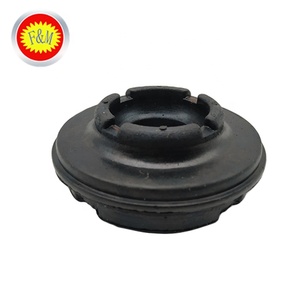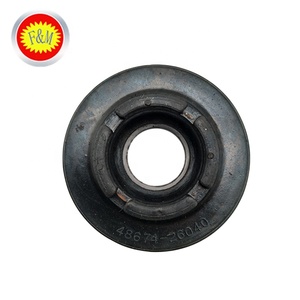
All categories
Featured selections
Trade Assurance
Buyer Central
Help Center
Get the app
Become a supplier

(6261 products available)








































The upper arm bushing is a component of the front suspension system on vehicles. It's a rubber part that's fitted into a metal sleeve. The upper arm bushing connects the upper control arm to the vehicle's frame. Its main job is to soften the noise and vibrations from the road. Bushings are usually made from rubber or polyurethane materials. The upper arm bushing comes in two main types, which are discussed below:
Rubber upper arm bushing
This type of bushing is made from conventional rubber material. It is the most common type found in older vehicle models. Rubber upper arm bushings offer a comfortable ride. They do a great job at dampening noise and vibrations from the road. This is because the rubber material is soft and flexible. Unfortunately, rubber upper arm bushings wear out quickly. The bushings can crack or tear apart after some time. This usually happens when the vehicle is driven on rough roads frequently. Another downside of this bushing is that it can't handle high temperatures. The rubber material can melt or become soft after prolonged use.
Polyurethane upper arm bushing
This bushing is made from polyurethane material. It is commonly used in modern vehicles. Polyurethane upper arm bushings are ideal for high-performance vehicles. They give a more precise and accurate steering response. The vehicle handles well on the roads. Polyurethane bushings are also more durable than rubber bushings. They can withstand wear and tear from regular use. Plus, they are suitable for heavy-duty applications. For example, vehicles that do a lot of off-road driving can benefit from these bushings. Polyurethane upper arm bushings are stiffer than rubber bushings. They produce a lot of noise and vibrations. The driver and passengers feel the bumps on the road. Polyurethane bushings are more expensive than rubber bushings.
Upper arm bushings are made with different materials, which affect their functionality and performance. Here are the specifications:
Material
The upper arm bushing is made from different materials, such as rubber, polyurethane, and nylon. Each material has its advantages and disadvantages. For instance, rubber bushings are quieter and absorb shocks better. However, they wear out faster than polyurethane and nylon bushings.
Size
The upper arm bushing comes in different sizes and diameters, depending on the specific vehicle model. The bushings have holes on both sides where the bolts pass through. The size of the hole varies based on the bushing size.
Functionality
The upper arm bushings help to reduce noise, vibration, and shocks in a vehicle. It ensures the upper arm pivots smoothly, keeping the tires in line with the vehicle. This helps to improve handling and steering.
Position
The upper arm bushing is used in the upper control arm and lower control arm in the suspension system. It is positioned between the arm and the frame of the vehicle.
Upper arm bushing maintenance is important to ensure it serves its purpose for a long time. Here are some maintenance tips:
Choosing the right upper arm bushings for a business can be a daunting task, especially with the different types and sizes on the market. Here are some tips to make the process easier:
Replacing upper arm bushings can be a DIY-friendly project. It is important to have the right tools and materials before starting. Here are the steps on how to replace upper arm bushings.
Tools Needed
Steps to Replace Upper Arm Bushings
Q1: What is an upper arm bushing?
A1: The upper arm bushing is a component found in the suspension system of vehicles. It acts as a cushion or liner between the upper control arm and the vehicle's frame or chassis. Typically, it reduces friction between the two parts it connects and allows for smoother movement. Bushings are usually made of rubber or polyurethane material.
Q2: What is the upper arm bushing's function in a vehicle's suspension system?
A2: The upper arm bushing plays a crucial role in maintaining the suspension system's upper control arm. It connects the control arm to the vehicle's frame or chassis, allowing the suspension to articulate while keeping the wheels aligned. This alignment ensures the wheels point in the right direction, affecting the vehicle's handling and stability. By doing this, the upper arm bushing helps control the vehicle's movement, providing a smooth ride and maintaining stability.
Q3: What materials are used to make upper arm bushings, and how do they differ?
A3: Upper arm bushings are typically made from two main materials: rubber and polyurethane. Rubber bushings have been used for a long time in the automotive industry. They are known for their ability to absorb vibrations, providing a smooth and quiet ride. On the other hand, polyurethane bushings are more durable and can withstand heavy loads and stress. They offer better performance by improving handling and stability. However, they are not as good as rubber bushings when it comes to noise and vibration dampening.
Q4: How can one tell if a bushing needs replacement?
A4: Bushing wear and tear can significantly affect a vehicle's performance and ride quality. Some signs to look out for include noise, which could be a result of the metal parts in the control arm and chassis coming into contact with each other, a loose upper arm bushing, vibration and shaking when driving, especially when accelerating, poor vehicle handling and stability, visible crackings and damages on the bushing, uneven tire wear, and a drop in the vehicle's height.
Q5: What is the difference between an upper arm bushing and a lower arm bushing?
A5: The upper and lower arm bushings perform the same function in a vehicle's suspension system. However, they differ in location. The upper arm bushing is located at the upper control arm, while the lower bushing is mounted on the lower control arm. Like the upper bushing, the lower arm bushing connects the control arm to the vehicle's chassis, allowing the suspension to work properly.